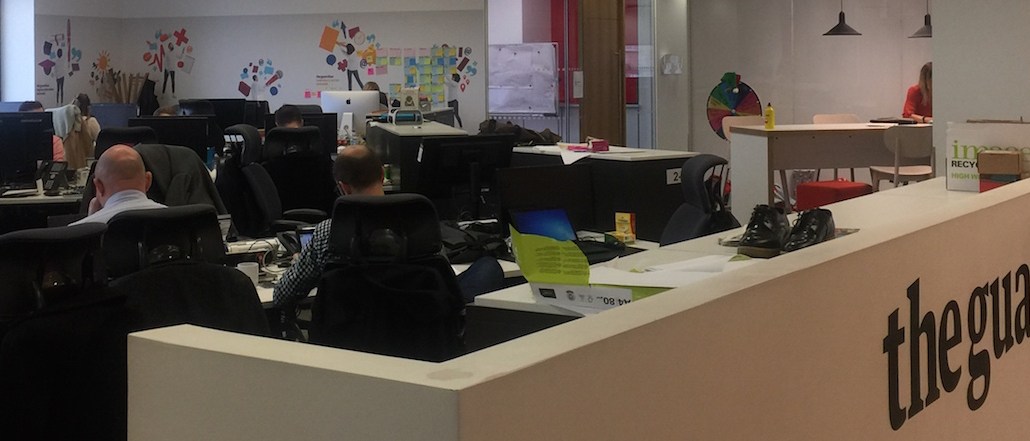Save 50% on a 3-month Digiday+ membership. Ends Dec 5.
‘Customers were becoming our competitors’: Why The Guardian created a hub for branded content

In a climate where publishers are increasingly competing against agencies in distributing branded content, the Guardian is launching “Hosted by the Guardian,” a new hub for advertiser-created content.
Brands have complained about spending large budgets on creating beautiful content that never gets seen. The Guardian’s aim is to use the power of its homepage to drive the Guardian’s loyal audience to advertiser-created content — be it video, photos or text.
“Branded content has become an increasingly crowded space. It’s not just our own competitors — more agencies and brands are creating branded content of their own. Our customers were becoming our competitors, which is a weird place to find yourselves in,” said The Guardian’s commercial strategy director Adam Foley.
The Guardian’s branded-content studio Labs has been around since 2014, but the new offering is focused solely on helping brands boost the distribution of the content some other advertiser has already created. Naturally, though, there’s potential to up-sell to Labs production in future.
“The quality of the content marketing in the U.K. is very high. But a lot of brands rely on seeding from third parties to get the actual content seen, which means it can often end up in low-quality areas,” said Foley. “Often the first thing a brand worries about is whether their content will slip through the cracks. We can drive a very influential and discerning audience to their content.”
All content is clearly labelled “Advertiser content” and will be featured in prominent spots on the homepage. The Guardian is confident that clear labeling of branded content drives better reader engagement and more meaningful results for advertisers. And the publisher has spent six months gaining evidence of this, running trials with 16 different campaigns across a range of verticals: airlines, finance, travel, leisure, alcohol, food, motors and entertainment.

Ad position: web_incontent_pos1
Auto brand Renault was among the test partners. The brand ran three of its videos on the new “The Guardian Hosts” page, one of which filmed a group of students from Central St. Martins art school, which took part in a competition to dream up the car of the future. A panel of Renault judges picked the winning design. The videos were created as part of Renault’s wider goals of promoting its electric model Zoe.
Underneath each video, a message reads, “Hosted content is used to describe content that is paid for and supplied by the advertiser.” Readers can then click through to a page which explains the commercial content guidelines. Typically, test-drive bookings are one of the standard methods for measuring campaign success, but in this case Renault just wanted to test the Guardian’s ability to drive view-through rates. The Guardian drove 25,000 unique visitors to the videos, which generated 4 percent click-through rates and 60 percent view-through rates to Renault’s own site, according to the publisher.
And yet, the Guardian is fed up on being judged by click-through rates as a metric for a campaign’s success. “CTR doesn’t really mean anything. It’s transitory, I don’t get why it’s become a benchmark for how media works,” said Foley. View-through rates for video and tracking if a campaign has genuinely helped drive a change in a target consumer’s behavior will be core ways the publisher will track success.
At a time when most publishers are seeing an ever-increasing amount of traffic driven from social media platforms like Facebook, relying on driving traffic purely from a publisher’s own homepage seems risky. Around 18 percent of Guardian site visitors come via Twitter and Facebook, but in general, The Guardian claims its homepage is the biggest traffic driver to its own pages. The theory is, therefore, that by focusing on driving lower numbers of highly engaged readers known to be loyal and spend more time within the site, rather than fly-by visitors that have come in via social media, it can offer more meaningful metrics for advertisers.
“Competitors may claim they can drive 600,000 page views and 0.4 percent CTRs, but we would prefer to drive 25,000 page views and 4 percent CTRs, and higher view-through rates,” said Foley. “The real advantage to everything being so clearly labeled is that those who do click through are a much more valuable audience for the brand, because they know it’s branded content.”
More in Media

Digiday+ Research Subscription Index 2025: Subscription strategies from Bloomberg, The New York Times, Vox and others
Digiday’s third annual Subscription Index examines and measures publishers’ subscription strategies to identify common approaches and key tactics among Bloomberg, The New York Times, Vox and others.

From lawsuits to lobbying: How publishers are fighting AI
We may be closing out 2025, but publishers aren’t retreating from the battle of AI search — some are escalating it, and they expect the fight to stretch deep into 2026.

Media Briefing: Publishers turn to vertical video to compete with creators and grow ad revenue in 2026
Publishers add vertical video feeds to their sites to boost engagement, attract video ad spend and compete with news creators.
Ad position: web_bfu
